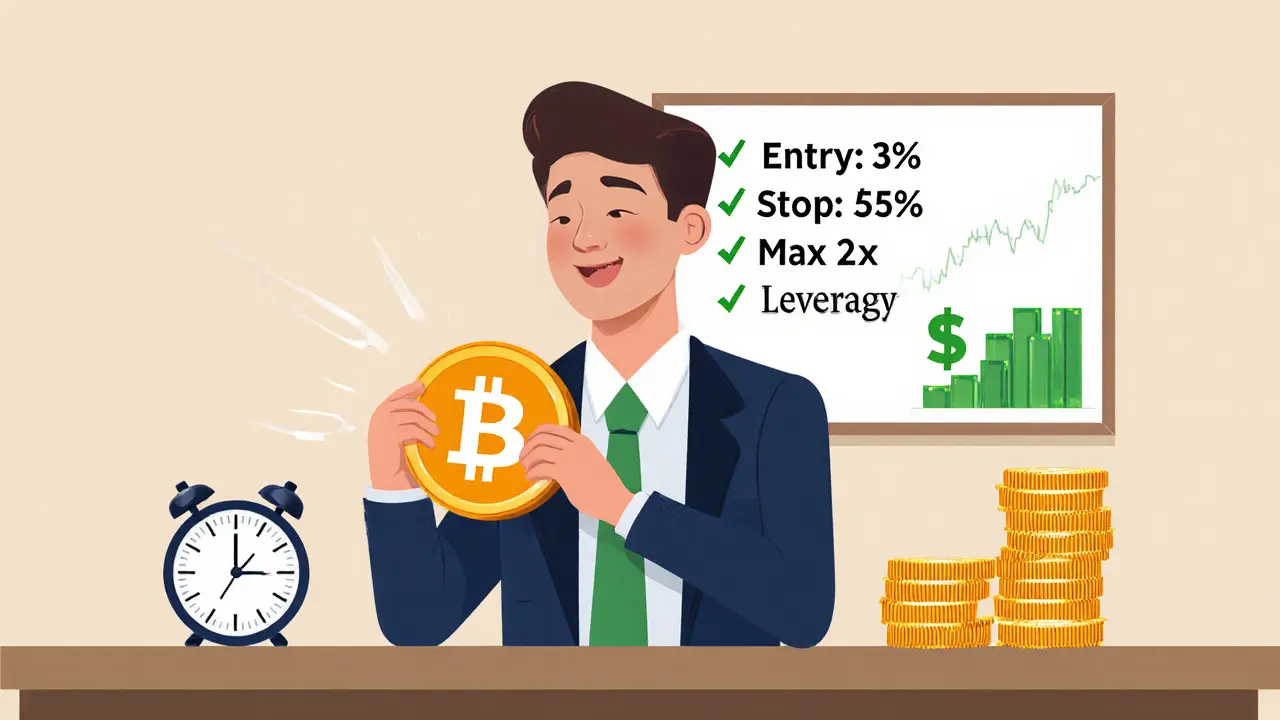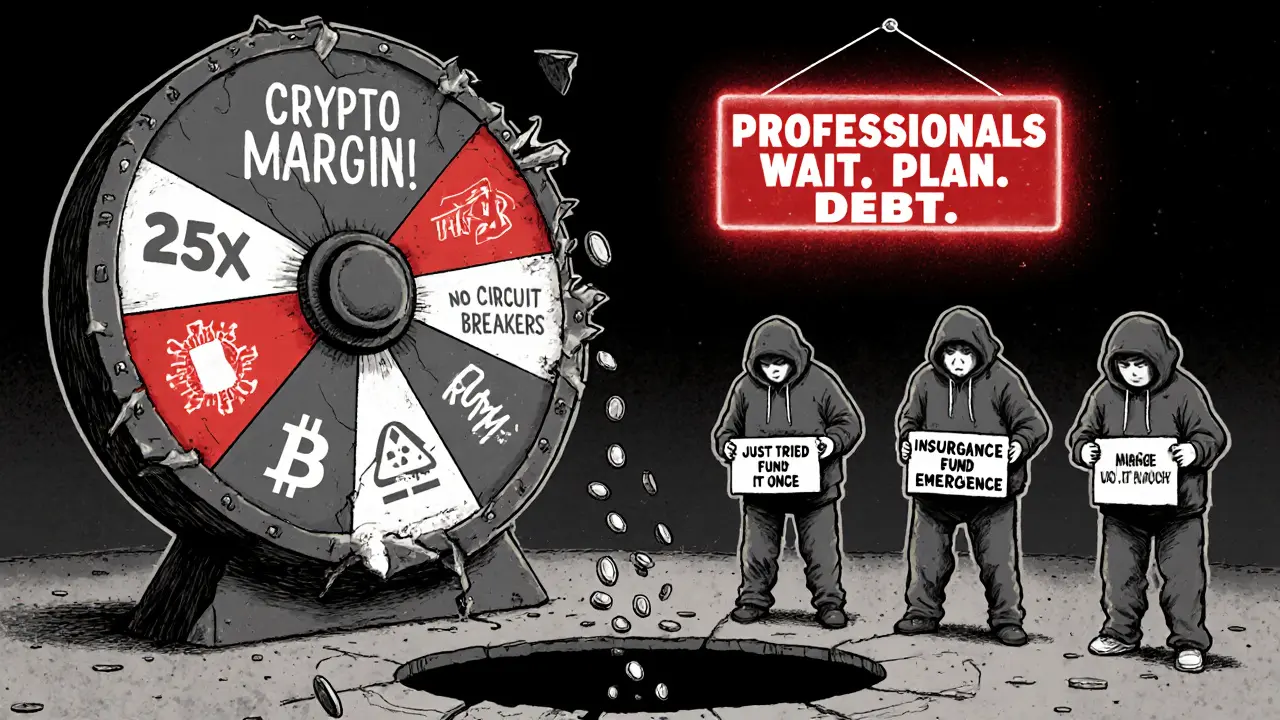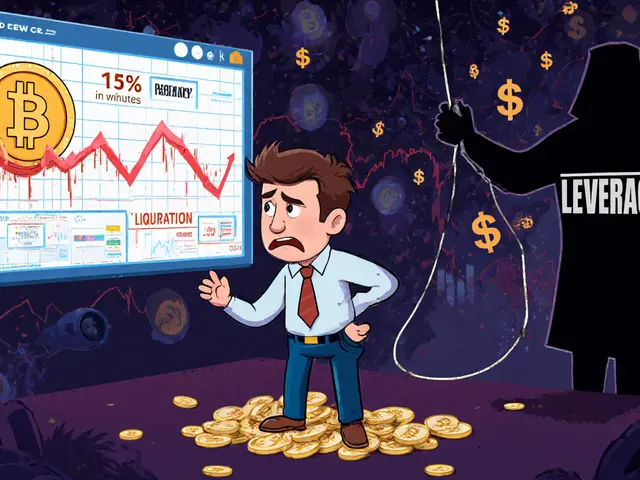Margin Trading Calculator
Position Size
$0.00
Equity
$0.00
Potential Profit/Loss
$0.00
Liquidation Price
$0.00
Maintenance Margin
0.00%
Risk Level
Low
When you trade crypto with margin, you’re not just betting on price moves-you’re betting with borrowed money. That means your wins can be bigger, but your losses? They can wipe out your account-and then some. In 2025, with Bitcoin swinging 15% in a single day and altcoins moving even harder, margin trading isn’t just common-it’s dangerous if you don’t know what you’re doing.
How Margin Trading Actually Works in Crypto
Margin trading lets you borrow funds from your exchange to open a position larger than your actual balance. If you have $1,000 and use 5x leverage, you control $5,000 worth of crypto. That sounds great if Ethereum jumps 10%. You’d make $500 instead of $100. But if it drops 10%? You lose $500. That’s your entire account gone.
Exchanges like Binance, Kraken, and Bybit offer leverage from 2x to 100x. Higher leverage means more risk. Most experienced traders stick to 5x or less. Why? Because crypto doesn’t move slowly. A 5% swing in a few hours can trigger a margin call before you even blink.
Every margin trade has three key numbers:
- Initial margin: The minimum amount you need to open the trade. For 5x leverage, you need 20% of the position value.
- Maintenance margin: The lowest equity you can have before the exchange starts liquidating your position. Usually around 5-10%.
- Margin call: When your account falls below maintenance margin, you get forced to add more funds-or your position gets sold automatically.
Let’s say you open a $5,000 BTC position with $1,000 (5x). If BTC drops 15%, your equity falls to $250. Most exchanges will liquidate you before you hit zero. You lose everything. No warning. No second chance.
The Rewards: Why People Still Do It
People use margin because crypto moves fast-and cash accounts are too slow to react. If you see a pump coming on Solana and you’re all in with cash, you might miss it. With margin, you can jump in immediately, even if you don’t have the full amount.
One trader in Austin doubled his $2,000 account in three weeks by correctly timing a Cardano rally with 8x leverage. He didn’t get lucky-he studied volume patterns, tracked whale wallets, and set strict stop-losses. He also kept 30% of his account in stablecoins as a buffer. That’s the difference between success and disaster.
Margin also gives you flexibility. Need cash fast? You can borrow against your holdings without selling. No waiting 2-3 days for settlement like with traditional banks. That’s why professional traders use it-not to gamble, but to manage liquidity.
Interest rates on crypto margin loans are usually between 0.01% and 0.1% per day. That’s $0.50 to $5 per $10,000 borrowed daily. Low, yes-but it adds up. If you hold a position for weeks, those fees can eat into your profits.
The Risks: When It All Goes Wrong
Here’s the brutal truth: margin trading can make you owe money you never had.
In early 2022, a trader on Binance used 25x leverage on a long ETH position. ETH dropped 40% in 12 hours. His account went to zero. Then the exchange’s insurance fund kicked in-and he still owed $8,000. He had to pay it back. That’s not a hypothetical. That’s real. And it’s happened to hundreds of people.
Unlike stocks, crypto has no circuit breakers. No halts. No pause buttons. If the market crashes, your position gets liquidated instantly. No mercy. No delay.
And here’s what most beginners don’t realize: you’re not just risking your deposit. You’re risking your entire financial safety net. If you use margin to trade with money you can’t afford to lose-your rent, your savings, your emergency fund-you’re playing Russian roulette with your life.
Studies from Chainalysis show that over 68% of retail traders who use leverage above 5x lose money within 90 days. The average loss? 72% of their initial capital. That’s not a strategy. That’s a trap.

Who Should Even Be Doing This?
Margin trading isn’t for beginners. It’s not for retirees. It’s not for people who check their portfolio once a week.
It’s for people who:
- Track markets 8+ hours a day
- Understand order books, funding rates, and liquidation levels
- Have a written trading plan with entry, exit, and stop-loss rules
- Keep 30-50% of their portfolio in stablecoins as a buffer
- Never risk more than 2-5% of their total capital on a single trade
One trader in Miami told me he only uses margin on BTC and ETH, never on memecoins. He sets his stop-loss 3% below his entry. He never trades during major news events. He pays his interest every Friday. He’s been profitable for 18 months. Not because he’s a genius. Because he’s disciplined.
How to Use Margin Without Getting Wiped Out
If you’re still considering it, here’s how to do it safely:
- Start with 2x leverage. No more. Even 2x is enough to make you feel the heat.
- Never use more than 10% of your total crypto holdings. If you have $10,000 in crypto, don’t borrow more than $1,000.
- Set a personal liquidation trigger. If your maintenance margin is 5%, set your stop at 10%. That gives you breathing room.
- Use limit orders, not market orders. Market orders during volatility can get you liquidated at terrible prices.
- Keep stablecoins ready. Have USDT or USDC on hand to add to your account if the market turns.
- Track funding rates. High positive funding rates mean longs are overextended. That’s a red flag for a potential drop.
One trader I know uses a simple rule: if his position is up 15%, he closes half. If it’s down 5%, he closes it entirely. No pride. No hoping. Just rules.

Margin vs. Other Crypto Leverage Tools
There are other ways to get leverage in crypto:
- Perpetual futures: These are contracts with no expiration. They have funding rates that can go negative or positive. More complex, but popular among pros.
- Options: You pay a premium for the right to buy or sell. Maximum loss is your premium. Safer, but less liquid.
- DeFi lending protocols: Platforms like Aave let you borrow against crypto. But they’re less regulated and can have smart contract risks.
Margin trading on centralized exchanges is the most straightforward-but also the most dangerous-way to get leverage. It’s the easiest to use, and the easiest to get wrecked by.
Final Reality Check
Margin trading isn’t a get-rich-quick scheme. It’s a high-stakes tool for people who treat it like a job. The people who make money with it don’t talk about it. They don’t post screenshots of their profits. They don’t chase pumps. They wait. They plan. They manage risk like their life depends on it.
And the people who lose? They’re the ones who thought, “I’ll just try it once.” Then they lost everything. Then they borrowed more to try again. Then they lost more.
If you’re not ready to spend hours learning, tracking, and managing your trades, don’t touch margin. Your crypto portfolio isn’t a casino. And you’re not here to gamble. You’re here to build.
Can you lose more than you invest with margin trading?
Yes. With margin trading, especially on crypto exchanges, you can owe more than your initial deposit. If the market moves sharply against your position and your account equity falls below zero, exchanges may use their insurance fund to cover the loss-but you’re still responsible for repaying the deficit. This has happened repeatedly in 2022-2025, with traders owing thousands after liquidations.
What’s the safest leverage level for beginners?
The safest leverage for beginners is 2x. Anything above 5x is considered high-risk even by professional traders. At 2x, you double your gains and losses, but you still have room to breathe during normal market swings. Most experienced traders avoid leverage above 5x unless they’re day trading with tight stop-losses.
How do I avoid a margin call?
To avoid a margin call, keep extra cash (in stablecoins) ready to deposit, set your stop-losses well above the exchange’s maintenance margin (e.g., 10% instead of 5%), and never use all your funds in a single trade. Also, avoid trading during major news events like Fed announcements or Bitcoin ETF decisions, when volatility spikes.
Is margin trading legal in the U.S.?
Yes, margin trading is legal in the U.S., but only on regulated exchanges like Kraken and Gemini. Binance.US and Coinbase Pro also offer limited margin services. However, the SEC has cracked down on unregulated platforms offering high-leverage trading. Always use licensed exchanges to avoid legal and financial risks.
Do I need to pay interest on margin loans?
Yes. Most exchanges charge daily interest on borrowed funds, typically between 0.01% and 0.1% per day. That might sound small, but over weeks or months, it adds up. For example, a $5,000 loan at 0.05% daily interest costs $2.50 per day, or $75 per month. Always factor interest into your profit calculations.
Can I use margin trading with Bitcoin only?
You can use margin on most major cryptocurrencies, including Bitcoin, Ethereum, Solana, and XRP. But Bitcoin is the safest choice because it has the highest liquidity and lowest slippage. Altcoins are riskier-lower volume means wider spreads and faster liquidations. Most experienced traders use margin only on BTC and ETH.

Arthur Crone
Margin trading is for people who think they're smarter than the market. Spoiler: they're not. 68% lose. That's not a statistic, it's a warning label. Stop pretending you're Warren Buffett with a Binance account.
Michael Heitzer
Look, I get it. Crypto moves fast. You want to ride the wave. But margin isn't a shortcut to wealth-it's a stress test for your discipline. I started with 2x. Lost 20% on my first trade. Didn't quit. Adjusted. Learned. Now I make consistent returns. It's not about luck. It's about structure. Plan your trades like your life depends on it-because it kinda does.
Rebecca Saffle
People who use margin are just gambling addicts with Excel sheets. You think you're a trader? You're a degenerate with a leverage slider. And don't give me that 'I'm disciplined' crap. If you're checking your phone every 10 minutes, you're not trading-you're chasing dopamine.
Adrian Bailey
Man i just started trading last year and i was totally hooked on margin like its a video game. i thought 10x was normal. then i lost 800 bucks in 3 hours on a solana pump that turned into a dump. i cried. not even joking. now i only use 2x and keep 40% in usdt. its boring as hell but i sleep at night. also i use stop losses now. who knew?
Rachel Everson
So many people treat margin like a lottery ticket. But if you’re serious about this, treat it like a business. Track everything. Journal your trades. Review your mistakes. And please, for the love of god, don’t risk money you need for rent. You’re not going to become a crypto millionaire overnight. But you can become a consistent, calm trader. That’s the real win.
Johanna Lesmayoux lamare
Stop using 5x. Just don't.
ty ty
Oh wow. A 1500 word essay on how to not blow up your account. Congrats. You just wrote the manual for people who can't read a warning sign. Maybe try not trading at all? Just a thought.
BRYAN CHAGUA
Margin trading is a tool. Like a chainsaw. You wouldn't use a chainsaw to trim your hedges without training. Yet people jump into 20x leverage with no education. The market doesn't care about your hopes. It only responds to logic, risk management, and discipline. If you're not willing to learn those, walk away.
Debraj Dutta
In India, margin trading is still new to most retail traders. Many think high leverage = high reward. But I've seen too many friends lose everything. I tell them: start with 1x. Learn the order book. Understand funding rates. Only then think about leverage. Patience beats greed every time.
tom west
Let's be real. The only people who profit from margin are the exchanges. They rake in fees, interest, and liquidation penalties. Retail traders? They're the bait. The system is designed to extract capital from you. Your 'strategy' is just noise. Your 'discipline' is a fantasy. The house always wins. Especially when you're borrowing at 0.05% daily and the market drops 10% in 4 minutes.
dhirendra pratap singh
OMG I JUST LOST MY ENTIRE LIFE SAVINGS ON 50X LEVERAGE ON PEPE 😭😭😭 I WAS SO CLOSE!!! THE WHALES PUMPED AND THEN DUMPED AND I WAS LEFT WITH NOTHING!!! I CRIED FOR 3 DAYS!!! NOW I'M ASKING MY MOM FOR MONEY TO GET BACK IN!!! SHE SAID NO!!! 😭😭😭 I JUST WANT TO BE RICH!!!
Ashley Mona
One thing that changed everything for me: I started treating margin like a surgeon treats a scalpel. No ego. No excitement. Just precision. I only trade BTC and ETH. I never go above 3x. I always have stablecoins on standby. And I close half my position at +15%. No greed. No drama. Just calm, consistent wins. It’s not sexy. But it’s sustainable. And honestly? That’s the most powerful thing you can do.
Edward Phuakwatana
Margin isn't about leverage-it's about capital efficiency. When you're operating at 2x with a 10% stop and 30% stablecoin buffer, you're not gambling. You're deploying capital with asymmetric risk/reward. The real edge? Time. The market doesn't reward speed-it rewards patience, precision, and position sizing. Most retail traders confuse volatility with opportunity. They're not traders. They're volatility junkies. And junkies don't build wealth-they burn through it.
Suhail Kashmiri
bro you think you're smart but you're just poor. margin is for rich people who lost money before. if you need to borrow to trade crypto, you should be working a real job. stop pretending you're a trader. you're just a broke guy with a phone.
Kristin LeGard
U.S. regulators are finally catching up. The SEC is coming for unregulated platforms. If you're using Binance or Bybit for high-leverage trades, you're already playing with fire. Don't be the guy who gets banned, frozen, or sued because you thought 'it's crypto, rules don't apply.' You're not a pioneer. You're a liability.